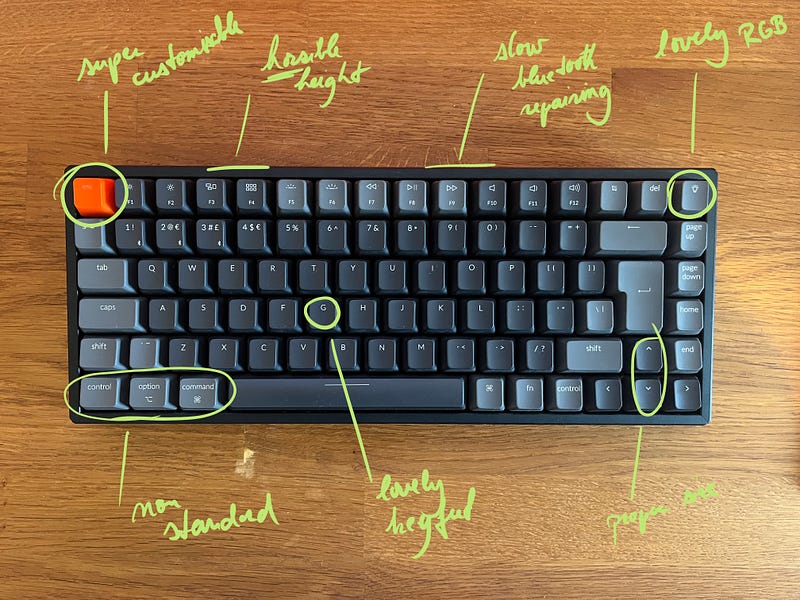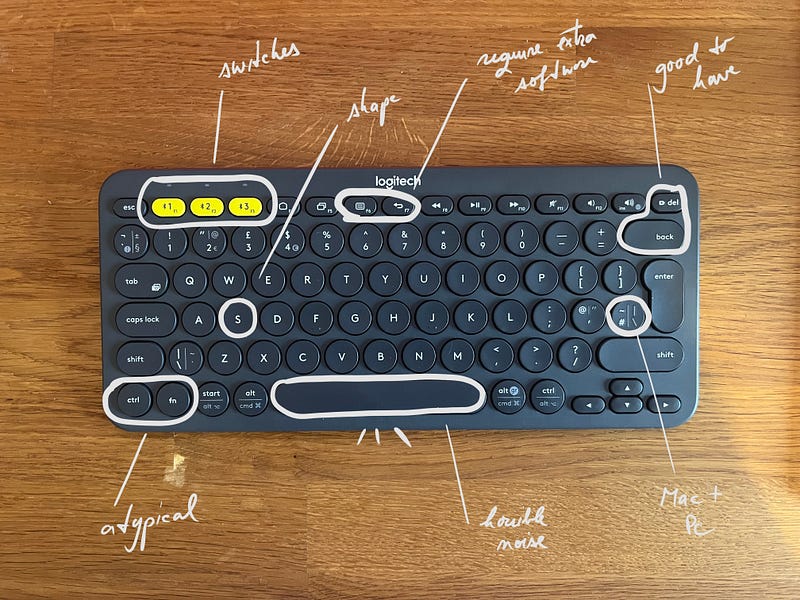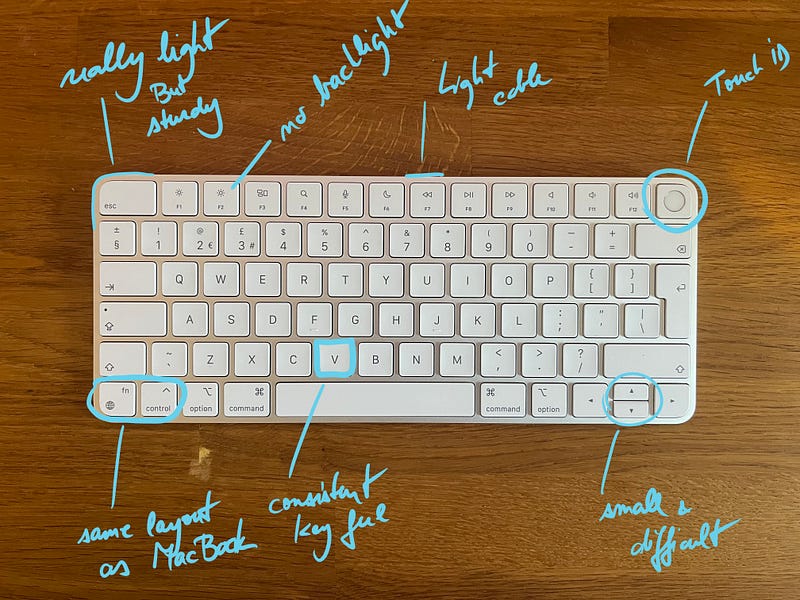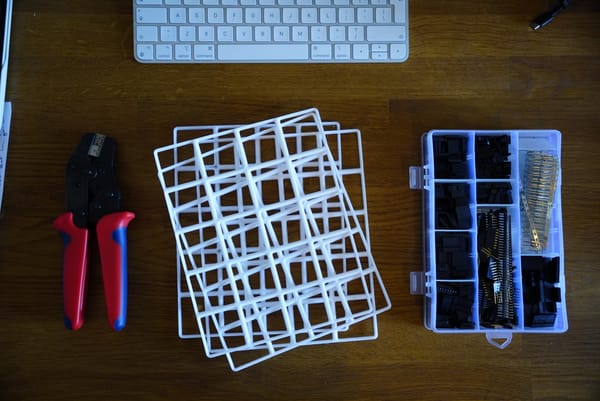⌨️ Keys to Productivity: A Consultant’s Guide to Choosing a Typing Tool
The Quest. Relative price-insensitive pursuit to find most comfortable, joyful, frictionless, rapid typing experience for my Mac.

The Quest.
Relative price-insensitive pursuit to find most comfortable, joyful, frictionless, rapid typing experience for my Mac.
About me.
- I love technology — not the specs, but how technology enables us
- My consulting practice centered around innovation, creative problem solving, complex change delivery
- I primarily use the Mac + Apple compute (could be an article in itself)
- No cables
- I see the keyboard as a key interface to capture thoughts/ ideas quickly AND also as a means for long-form writing (business cases, plans, etc)
A bit about my candidates, for people in a hurry.
There are 3 angles I approached this, with avatars I considered worthy:
- Keychron to represent the magic of mechincal keyboards
- Logitech to represent the beauty of compant + universal
- Apple to represent the coherence potential of one system
Before we go into my findings, let me briefly share with you a few words about the candidates (I also added a 🏅 for the one that wins each spec category)
Note: If you know all of the specs already, feel free to scroll to my experience (which you might find.. unexpected!) — I won’t mind, your time is valuable.
Keychron K2v2 (had this for the longest time)
- 🏅 Connectivity: Bluetooth and USB Type-C wired connection.
- 🏅 Switches: Available in Gateron Red, Blue, Brown, or Yellow mechanical switches (I have Brown).
- 🏅 Keycap Material: ABS or PBT (depending on the version).
- 🏅 Backlight: Adjustable RGB backlight with multiple lighting modes.
- Battery: 4000mAh rechargeable lithium battery (few weeks in my case).
- Compatibility: everything — MacOS, Windows, and Android.
- Frame Material: Aluminum frame (for some versions, including mine) or plastic.
- Layout: Compact 84-key design.
- Dimensions: 317mm x 129mm x 38.5mm.
- Weight: Varies with the model, around 794g. It feels solid.
- 🏅 Hot-swappable Option: Some versions allow for hot-swapping of switches, enabling you to change switches without soldering. I thought I’d take advantage of this, but couldn’t be asked…
- Multiple Device Connectivity: Can connect up to three devices via Bluetooth and switch between them seamlessly (FN + 1, 2, 3).
- Mac and Windows Layouts: Includes keycaps for both macOS and Windows, ensuring a seamless typing experience on either operating system. Set and forget.
- Adjustable Feet: Offers two levels of incline for a more comfortable typing angle.
Logitech K380
- Connectivity: Bluetooth for up to three devices.
- Switches: Scissor mechanism.
- Keycap Material: Plastic (probably ABS).
- Backlight: No backlight.
- 🏅 Battery: 2 x AAA batteries with an estimated 2-year lifespan.
- Compatibility: Everything.
- Frame Material: Plastic.
- Layout: Compact layout with 79 keys.
- Dimensions: 279mm x 124mm x 16mm.
- Weight: 423g.
- 🏅 Multi-Device Connectivity: Easily switch between three Bluetooth devices with the touch of a button (one button — not a combination).
- Compact and Portable: Slim and lightweight design makes it easy to carry around for mobile work setups.
- OS Adaptive: Automatically recognizes each device and maps keys to give you a familiar layout (you don’t have to switch between OS layouts manually).
- 🏅 Long Battery Life: Up to 2 years of battery life from two AAA batteries, reducing the need for frequent replacements.
Magic Keyboard with Touch ID
- Connectivity: Lightning port and Bluetooth.
- Switches: Scissor mechanism.
- Keycap Material: Plastic.
- Backlight: No backlight.
- Battery: Rechargeable lithium-ion battery (spec is not published).
- Compatibility: macOS with Apple silicon (for Touch ID functionality).
- Frame Material: Aluminum.
- Layout: Compact layout without numeric keypad.
- Dimensions: 279.9mm x 114.9mm x 4.1mm to 10.9mm (front to back height).
- 🏅 Weight: 231g.
- Special Features: Touch ID sensor integrated into the keyboard for secure authentication and Apple Pay.
- 🏅 Touch ID: Enables fast, easy, and secure authentication and Apple Pay transactions.
- Compact Design: Sleek, minimalistic design that saves space and complements Apple devices.
- Rechargeable Battery: Offers a long-lasting internal battery that’s rechargeable via a Lightning cable, reducing the need for disposable batteries.
- Instant Pairing: Automatically pairs with your Mac using a Lightning cable (but good luck seemlessly switching between devices)
The showdown!!
I used each extensively in real world working scenarios. I types on them like my job depended on them. I leaned into the experience each tool was trying to nudge me into. These are my thoughts…
Keychron — the giant

😍 Loved…
- Size of the keyboard + layout
- Key feel + sound — everything feels well made and a joy to type on
- RGB makes typing a joy
- Customisation (i loved the ability to swap the keycaps around)
- The forward delete key (which i use all the time between both Logi and this)
- Key shapes are very well defined -> you can achieve a lot by feel alone
😐 Neither here nor there about…
- Battery life is short — I have to charge it more than I’d like to (I think once every 2–3 weeks)
😕 Mildly annoyed about…
- Different layout between this and the macbook native keys (which i don’t have the luxury of outsourcing, since that’s what i type on whne i’m traveling)
😡 Hated…
- If goes to sleep all the time, and waking it up creates just a few seconds of friction that interrupt your flow
- Height makes it difficult to type on without a wrist rest AND it also makes it difficult to play with a trackpad at the same time (since the height difference is so significant)
- that’s why, my typing position is not great and i feel like i use the keyboard less because of its position (for conclusion: i really wanted to love this, but it’s difficult since the distance means that i use the keyboard less. for conclusion: we may need change in our lives, so most likely, i’ll go back between these keyboards)
Logi K380

😍 Loved…
- Easy switching between machines — honestly, this is beautiful! One key and you’re typing on the iPhone, one key and you’re on the Mac
- Flat profile on the table, easy to type on without any hand gymnastics
- Automatically adjusts between MacOS and Windows
😐 Neither here nor there about…
- You miss out on the first 3 function keys by default
- Removable batteries you have to provide (but the battery life is really good)
😕 Mildly annoyed about…
- You have to install Logitech software to make use of the majority of the function keys, which is annoying — Logitech, I don’t want another Emoji button. I just want the default functions.
- Round keys, harder to type on, easier to miss (especially the Enter key for me — I consistently overshot it)
- Not backlit — which makes a bigger difference when the keys themselves don’t have a huge amount of contrast to them
😡 Hated…
- The noises! Keys developed a mild squeak (mild squeak * 1,000 presses per hour = deal breaker)
- Non-standard sequencing of the modifier keys (would have loved consistency with the Mac — the FN key is sandwiched in between CTRL and ALT)
Apple Magic Keyboard

😍 Loved…
- Typing on it is a joy — no strain and high-quality + good speed
- Wakes up instantly (or doesn’t go to sleep ever perhaps?)
- Solid but also super light and thin (don’t know how they achieve this)
- Exactly the same layout as my MacBook, which means no readjustment every time I travel — this is especially valuable because I use shortcuts with modifier keys all the time, so I rely on muscle memory
- Near silent keys — you won’t be distracted by the sound of this keyboard if someone is taking notes while on calls
😐 Neither here nor there about…
- Lightning port for charging — I don’t care about this because my Magic Trackpad and my AirPods and my iPhone use it (for now)
- You can unlock the Mac with it, but it’s not instant (it’s about as fast as the Apple Watch would do it, and nowhere near as fast as the native fingerprint reader on the laptop itself)
😕 Mildly annoyed about…
- White — it stands out, and my theme is a lot darker around my desk
- No backlight (although, with the white keycaps, this is far less of an issue than it is on the Logi)
😡 Hated…
- Pairing happens in a non-standard way that doesn’t play well even with Apple’s own devices (e.g. your Touch ID disappears after you dare to pair it with an iPad, and you have to reinsert the cable to repair with the Mac) — I’m tethered to one device more than I would be with a wired keyboard!
- Keys are very homogenous and geometrically spaced — it takes some time to get used to (compared e.g. with the edges and ample curves on the Keychron)
Final thoughts
I wish there was a perfect keyboard, especially as I sue it so much
Ultimately, for me, it comes down to what I value most both in the positive and the negative
I hate the Logi squeak, I dislike strongly the strain and difference between the trackpad and the Keychron mechanical keyboard (when you see the Magic Keyboard, the Keychron looks truly gigantic)
I love to be able to type quickly and effortlessly, mindlessly, without looking at the keyboard (which makes the backlight and the RGB less important since the goal is to not look down there at all)
For my setup, to minimise friction, maximise joy, I have to default to the Magic Keyboard for now. But I’ll keep my Keychron close! It is a lot to give, and it is very pleasant.
I’d recommend the Logitech if your budget is tighter, and also if you need to switch a lot between known devices (I just don’t switch often enough for this to truly make a difference— my iPad is just an iPad that i use 95% without a keyboard near it)
It’s great to be able to try all of this out, fine tune my setup and be able to share this with you. I’m eager to hear about your experience + any recommendations you might have!! 👋



